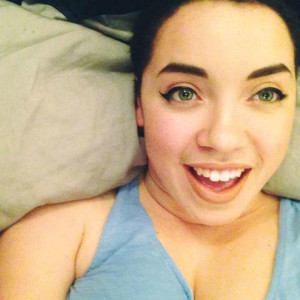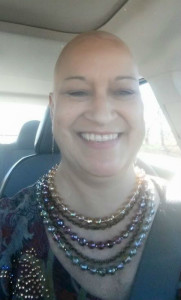As an homage to the George et Jon show at the Salina Art Center, here are three selfies I found on my social network Facebook, with many thanks to the contributors! I have obtained permission from each person to share them with you here as described in my previous post, and will answer for you the Five Key Questions of Media Literacy. Normally, when viewing media you don’t usually know the creator, but in some of these, I do. I will try to answer as if I don’t know them, but instead try to “read” the photo as my students & I did recently the Salina Art Center exhibit.
Photo #1.
- Who created this message?
A young woman. There is not much in the photo’s background to give us a hint about who she is. That was part of the fun at the Salina Art Center show, trying to make up a story about the people we saw there. Since I know this person, I’ll leave it to you to decide who she is and what she is about. I’ll just say she is a private citizen from Facebook.
- What creative techniques are used to attract my attention?
She has a bit of a smirk, and one of her eyes is partially covered, which adds to the mystery of this photo. It is a close-up portrait, and these are always dramatic. It’s a selfie photo created so others can see her, but to me, I see a hint of discomfort, perhaps a wondering in her mind of how people will react to seeing this. But I also see authenticity here, something real and trustworthy.
- How might different people understand this message differently than me?
I think this picture was made primarily for friends and family. My putting it on this blog invites a variety of other interpretations. She is a fair-haired, white American lady. People from other ethnicities or cultures may see her entirely different from me. Some people might see her a person of great privilege, having many advantages that most people in the world do not have, including wealth, youth, and beauty. Do some people believe the stereotype about blondes having more fun, but not being too bright? I suppose some might think that way too.
- What lifestyles, values and points of view are represented in; or omitted from, this message?
The point of view represented seems to be one of typical middle class America. I think there are many people in this country who live with much less, and also some people who have a great deal more when it comes to material possessions. She’s not a showy person in this photo, but doesn’t seem to be suffering either.
- Why is this message being sent?
I think she made it for a boyfriend, or just friends in general. Unlike many media messages, she doesn’t seem to be trying to gain followers, or influence by sharing this. It’s just a slice of her life she’s sharing with others, I think.
Photo #2.

- Who created this message?
Another young woman making a selfie photo.
- What creative techniques are used to attract my attention?
Youth and beauty, once again get our attention, along with a big grin and sort of an amazed expression. Selfies are tricky because the camera lens is offset from the viewing screen. It looks like she’s looking at herself, because she’s not looking directly into the camera. It also looks like this was taken in bed, which suggests vulnerability. Her bubbly personality shines through, and it looks as though she is probably great fun to be around.
- How might different people understand this message differently than me?
Some people might think this picture was made to draw attention to herself. She’s actually a beautiful young woman, but I think some people in our superficial culture might be cruel to her because she doesn’t have the anorexic body of a runway model. Again, people of other ethnicities and cultures might see things quite differently.
- What lifestyles, values and points of view are represented in; or omitted from, this message?
I’m a dad of a young daughter, and I wonder what her dad would say about this photo. There’s nothing particularly revealing going on, but it’s a picture from bed (and maybe wearing pj’s?) so it could be interpreted as a suggestive photo by some.
- Why is this message being sent?
I think she’s just having fun. It is intended to make others smile, and perhaps remind people who know her why they love her so much.
Photo #3.
- Who created this message?
This looks like the photo of a woman who has been through hell, and lived to tell about it.
- What creative techniques are used to attract my attention?
The first time I saw a woman wearing this hairstyle was in Star Trek – The Motion Picture. It was so unusual to see a lady with no hair, but I was only about eleven years old at the time. I was transfixed. Now I know there is probably more to the story of why she looks like she does. Her smile says that she knows she looks different, but she doesn’t really care what others think. She’s too busy enjoying life to be self-conscious. The photo makes me smile. It shows dogged determination and a will to get better.
- How might different people understand this message differently than me?
Certainly those who have endured life-threatening illnesses would interpret this message differently than I do. They might know exactly how she feels, when I can only guess. Also, it might be that someone might think that she’s shaved her head on purpose to show solidarity with someone who is ill, but is not actually ill herself. Others might even suspect she’s one of those people who fakes an illness to gain attention and sympathy, but I would hope that most people wouldn’t think that.
- What lifestyles, values and points of view are represented in; or omitted from, this message?
I think that cancer-survivor is the point of view that is represented. A point of view that is omitted is that of her family. Does she have a spouse or kids going through this with her? How long has she been like this? Is this a recent picture, or is this something that happened a while ago?
- Why is this message being sent?
I think this is mostly an invitation for the viewer to celebrate life with her. I don’t see it as an appeal for sympathy. It might be to get attention, but only in a positive way, such as to raise awareness about people who are quietly suffering through life-threatening illnesses every day.
So how did I do? Am I way off with this analysis? Do you see things another way? I invite you to share your thoughtful ideas in the comments below.

